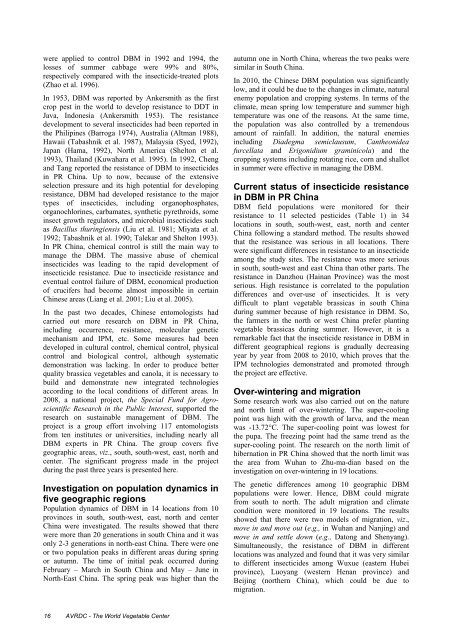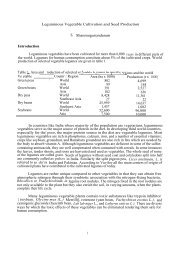Management of the Diamondback Moth and Other Crucifer Insect ...
Management of the Diamondback Moth and Other Crucifer Insect ...
Management of the Diamondback Moth and Other Crucifer Insect ...
You also want an ePaper? Increase the reach of your titles
YUMPU automatically turns print PDFs into web optimized ePapers that Google loves.
were applied to control DBM in 1992 <strong>and</strong> 1994, <strong>the</strong>losses <strong>of</strong> summer cabbage were 99% <strong>and</strong> 80%,respectively compared with <strong>the</strong> insecticide-treated plots(Zhao et al. 1996).In 1953, DBM was reported by Ankersmith as <strong>the</strong> firstcrop pest in <strong>the</strong> world to develop resistance to DDT inJava, Indonesia (Ankersmith 1953). The resistancedevelopment to several insecticides had been reported in<strong>the</strong> Philipines (Barroga 1974), Australia (Altman 1988),Hawaii (Tabashnik et al. 1987), Malaysia (Syed, 1992),Japan (Hama, 1992), North America (Shelton et al.1993), Thail<strong>and</strong> (Kuwahara et al. 1995). In 1992, Cheng<strong>and</strong> Tang reported <strong>the</strong> resistance <strong>of</strong> DBM to insecticidesin PR China. Up to now, because <strong>of</strong> <strong>the</strong> extensiveselection pressure <strong>and</strong> its high potential for developingresistance, DBM had developed resistance to <strong>the</strong> majortypes <strong>of</strong> insecticides, including organophosphates,organochlorines, carbamates, syn<strong>the</strong>tic pyrethroids, someinsect growth regulators, <strong>and</strong> microbial insecticides suchas Bacillus thuringiensis (Liu et al. 1981; Miyata et al.1992; Tabashnik et al. 1990; Talekar <strong>and</strong> Shelton 1993).In PR China, chemical control is still <strong>the</strong> main way tomanage <strong>the</strong> DBM. The massive abuse <strong>of</strong> chemicalinsecticides was leading to <strong>the</strong> rapid development <strong>of</strong>insecticide resistance. Due to insecticide resistance <strong>and</strong>eventual control failure <strong>of</strong> DBM, economical production<strong>of</strong> crucifers had become almost impossible in certainChinese areas (Liang et al. 2001; Liu et al. 2005).In <strong>the</strong> past two decades, Chinese entomologists hadcarried out more research on DBM in PR China,including occurrence, resistance, molecular geneticmechanism <strong>and</strong> IPM, etc. Some measures had beendeveloped in cultural control, chemical control, physicalcontrol <strong>and</strong> biological control, although systematicdemonstration was lacking. In order to produce betterquality brassica vegetables <strong>and</strong> canola, it is necessary tobuild <strong>and</strong> demonstrate new integrated technologiesaccording to <strong>the</strong> local conditions <strong>of</strong> different areas. In2008, a national project, <strong>the</strong> Special Fund for AgroscientificResearch in <strong>the</strong> Public Interest, supported <strong>the</strong>research on sustainable management <strong>of</strong> DBM. Theproject is a group effort involving 117 entomologistsfrom ten institutes or universities, including nearly allDBM experts in PR China. The group covers fivegeographic areas, viz., south, south-west, east, north <strong>and</strong>center. The significant progress made in <strong>the</strong> projectduring <strong>the</strong> past three years is presented here.Investigation on population dynamics infive geographic regionsPopulation dynamics <strong>of</strong> DBM in 14 locations from 10provinces in south, south-west, east, north <strong>and</strong> centerChina were investigated. The results showed that <strong>the</strong>rewere more than 20 generations in south China <strong>and</strong> it wasonly 2-3 generations in north-east China. There were oneor two population peaks in different areas during springor autumn. The time <strong>of</strong> initial peak occurred duringFebruary – March in South China <strong>and</strong> May – June inNorth-East China. The spring peak was higher than <strong>the</strong>autumn one in North China, whereas <strong>the</strong> two peaks weresimilar in South China.In 2010, <strong>the</strong> Chinese DBM population was significantlylow, <strong>and</strong> it could be due to <strong>the</strong> changes in climate, naturalenemy population <strong>and</strong> cropping systems. In terms <strong>of</strong> <strong>the</strong>climate, mean spring low temperature <strong>and</strong> summer hightemperature was one <strong>of</strong> <strong>the</strong> reasons. At <strong>the</strong> same time,<strong>the</strong> population was also controlled by a tremendousamount <strong>of</strong> rainfall. In addition, <strong>the</strong> natural enemiesincluding Diadegma semiclausum, Can<strong>the</strong>onideafurcellata <strong>and</strong> Erigonidium graminicola) <strong>and</strong> <strong>the</strong>cropping systems including rotating rice, corn <strong>and</strong> shallotin summer were effective in managing <strong>the</strong> DBM.Current status <strong>of</strong> insecticide resistancein DBM in PR ChinaDBM field populations were monitored for <strong>the</strong>irresistance to 11 selected pesticides (Table 1) in 34locations in south, south-west, east, north <strong>and</strong> centerChina following a st<strong>and</strong>ard method. The results showedthat <strong>the</strong> resistance was serious in all locations. Therewere significant differences in resistance to an insecticideamong <strong>the</strong> study sites. The resistance was more seriousin south, south-west <strong>and</strong> east China than o<strong>the</strong>r parts. Theresistance in Danzhou (Hainan Province) was <strong>the</strong> mostserious. High resistance is correlated to <strong>the</strong> populationdifferences <strong>and</strong> over-use <strong>of</strong> insecticides. It is verydifficult to plant vegetable brassicas in south Chinaduring summer because <strong>of</strong> high resistance in DBM. So,<strong>the</strong> farmers in <strong>the</strong> north or west China prefer plantingvegetable brassicas during summer. However, it is aremarkable fact that <strong>the</strong> insecticide resistance in DBM indifferent geographical regions is gradually decreasingyear by year from 2008 to 2010, which proves that <strong>the</strong>IPM technologies demonstrated <strong>and</strong> promoted through<strong>the</strong> project are effective.Over-wintering <strong>and</strong> migrationSome research work was also carried out on <strong>the</strong> nature<strong>and</strong> north limit <strong>of</strong> over-wintering. The super-coolingpoint was high with <strong>the</strong> growth <strong>of</strong> larva, <strong>and</strong> <strong>the</strong> meanwas -13.72°C. The super-cooling point was lowest for<strong>the</strong> pupa. The freezing point had <strong>the</strong> same trend as <strong>the</strong>super-cooling point. The research on <strong>the</strong> north limit <strong>of</strong>hibernation in PR China showed that <strong>the</strong> north limit was<strong>the</strong> area from Wuhan to Zhu-ma-dian based on <strong>the</strong>investigation on over-wintering in 19 locations.The genetic differences among 10 geographic DBMpopulations were lower. Hence, DBM could migratefrom south to north. The adult migration <strong>and</strong> climatecondition were monitored in 19 locations. The resultsshowed that <strong>the</strong>re were two models <strong>of</strong> migration, viz.,move in <strong>and</strong> move out (e.g., in Wuhan <strong>and</strong> Nanjing) <strong>and</strong>move in <strong>and</strong> settle down (e.g., Datong <strong>and</strong> Shenyang).Simultaneously, <strong>the</strong> resistance <strong>of</strong> DBM in differentlocations was analyzed <strong>and</strong> found that it was very similarto different insecticides among Wuxue (eastern Hubeiprovince), Luoyang (western Henan province) <strong>and</strong>Beijing (nor<strong>the</strong>rn China), which could be due tomigration.16 AVRDC - The World Vegetable Center
















